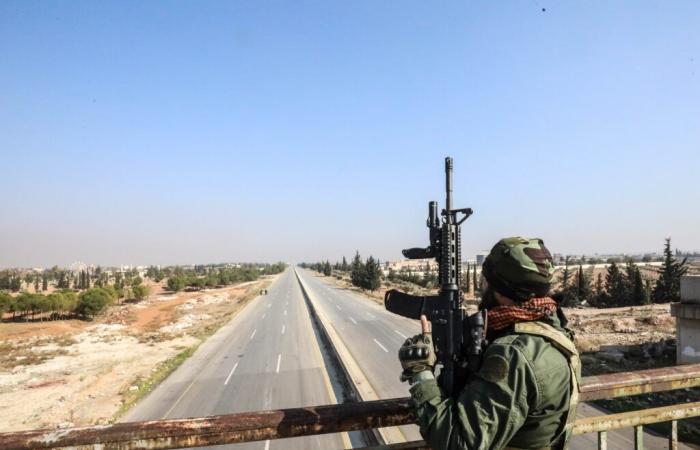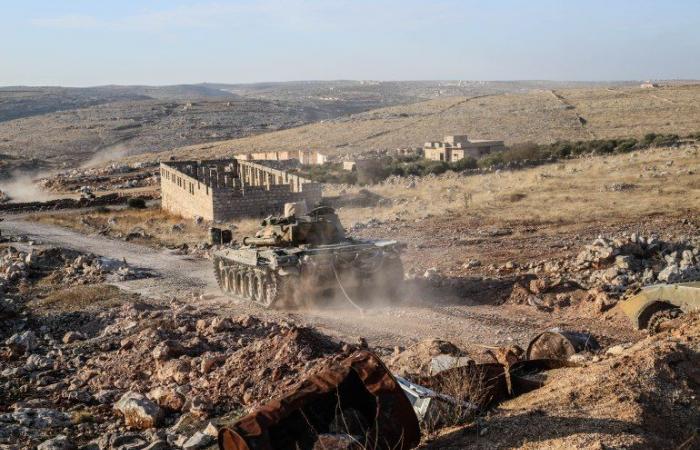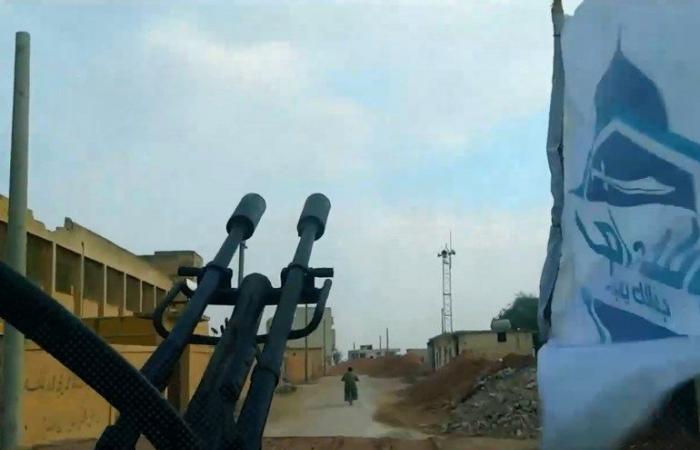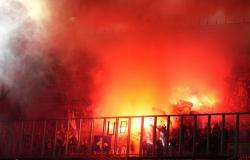After a calm that lasted for nearly 5 years, the regions of northern Syria are witnessing an accelerating military escalation following the Syrian opposition factions’ surprise attack on Wednesday, November 27, on regime positions in the western countryside of Aleppo.
The operation, called “Deterring Aggression,” resulted in the opposition taking control of vast areas of the western countryside of Aleppo and eastern Idlib within less than 48 hours of the start of the attack.
The opposition formed a “military operations management” room at the beginning of the attack, and it includes Hay’at Tahrir al-Sham and another from the opposition’s Syrian National Army, in addition to a number of opposition factions in Idlib.
She said that the attack comes within the framework of curbing the regime, which threatens to begin military action on Idlib Governorate, and escalates its bombardment with artillery, missiles, and bomb-laden aircraft.
The last clashes that these areas witnessed were in March 2020 after the signing of the “Sochi” agreement between Turkey and Russia, but from time to time they witnessed violations by the regime and Russia, leading to casualties, most of them civilians.
Today, this operation comes in overlapping international and regional circumstances, following the Israeli escalation in the region, and Syria was one of its arenas by targeting sites affiliated with Iran and Hezbollah.
Multiple goals
The Syrian opposition factions set the general goals of this operation, which are to break the regime’s plans by directing a calculated pre-emptive strike against the positions of its forces and militias affiliated with it.
The spokesman for the Military Operations Room, Commander Hassan Abdul Ghani, confirmed that defending civilians in opposition-controlled areas “is not an option, but rather a duty,” stressing that “their consistent goal is to return the displaced to their homes.”
However, the successive field developments and the continuous progress of the opposition forces indicate that there are greater goals than those that have been announced. In this context, the leader of the Ahrar al-Sham movement, Amer al-Sheikh, says on his page on the X platform that the process of deterring aggression continues until its goals of stopping the regime’s attacks are achieved, Removing the threat of Iranian militias from opposition-controlled areas, and creating appropriate conditions for the safe return of people to their land.
According to observers, the general objectives of this operation can be set by expanding the opposition-controlled areas, ensuring the return of civilians to their homes, and alleviating the massive population pressure on the rest of the areas, in addition to neutralizing the artillery and drones that target civilians in the opposition areas.
According to the “Syrian Response Coordinators” team, the countryside of Aleppo and Idlib was subjected, from the beginning of this year until last October 25, to more than 256 attacks by 874 suicide drones from the Syrian regime forces, which led to the death of 34 civilians and the injury of 88, including women and children.
For his part, the strategic analyst, Colonel Ahmed Hamada, in his interview with Al Jazeera Net, believes that the geographical goal of this operation is open because the field reality is governed by it on the one hand, and because the factions that launched this attack have not announced their ultimate goal of this operation on the other hand, as it may include All the de-escalation zones that were agreed upon in 2017, which extend to the Morek area in the northern Hama countryside, and may expand to include the city of Aleppo as well.
In addition to defending the liberated areas, which were subjected to repeated attacks by the regime and its allies through artillery or air bombardment, or even via bomb-laden aircraft recently, it seems clear that there are political goals for this operation, which are to move the Syrian file forward and restore international interest in it, after the situation… The stagnation that he has experienced during the past six years, according to Colonel Hamadeh.
Rapid field developments
The accelerated field progress and control of new positions of the Syrian regime forces may be one of the most prominent features of this operation, as the opposition forces were able in the first hours of the launch of the operation to control important sites and hills in the western countryside of Aleppo, most notably Sheikh Aqeel, Anjara, and the strategic “46th Regiment.”
Thus, the area of the area controlled by the opposition on the first day of the operation reached 245 square kilometers, and it became 5 kilometers from the city of Aleppo, in addition to the killing of dozens of regime forces, and the seizure of many weapons and cannons, including the “Cornet” missile warehouse, according to the Chamber. “Military Operations Department.”
The opposition factions concluded the second day’s confrontations, achieving rapid and remarkable progress on various fronts in the western countryside of Aleppo and the eastern countryside of Idlib, in addition to Al-Zarbah and Khan Al-Asal, which enabled them to cut off the Aleppo-Damascus international road.
It was also able to target regime forces’ positions in the heart of the city of Aleppo for the first time since the start of the operation, amid reports indicating the arrival of the factions’ vanguards to the outskirts of the city of Aleppo, after the “Military Operations” Room yesterday announced control over the entire western countryside of the city of Aleppo.
Commenting on this rapid progress, the former leader of the military opposition, Colonel Abdul-Jabbar Al-Aqidi, in his interview with Al-Jazeera Net, explains that the reasons for this lie in military planning and unified management of operations, in addition to the presence of local weapons, and the rapid collapse of the regime’s forces and militias affiliated with it in light of the lack of There is no actual participation of Russian aviation so far.
Yesterday, Thursday, the Syrian opposition announced for the first time the use of drones called the “Shaheen Brigades,” through which they bombed regime helicopters at the Nayrab military airport.
As for the most important factor, in Al-Aqidi’s opinion, it is “uniting the factions with one operations room, which is the management of military operations, and rejecting the differences between the factions, which are now fighting shoulder to shoulder, even though they have been fighting with each other for days.”
The regime’s comment on the attack
In the Syrian regime’s first comment on the attack, the Ministry of Defense announced that the opposition factions launched a large-scale attack on Wednesday, on a number of villages, towns and military points in the Aleppo and Idlib countryside, noting that they “confronted it” and confirming that the attack is still continuing.
The ministry said in a statement on Thursday morning that – what it called – armed terrorist organizations affiliated with the Al-Nusra Front and located in the countryside of Aleppo and Idlib, “launched a major attack on a wide front on Wednesday morning with large numbers of terrorists and using medium and heavy weapons, targeting safe villages and towns and our military points in those areas.” “regions.”
The statement said that the attack was confronted, “which is still ongoing, and the attacking terrorist organizations have suffered heavy losses in equipment and lives, and our forces are confronting the terrorist organizations with various means of fire and in cooperation with friendly forces.”
Timing of the attack
Since the beginning of the regional escalation in the region after Operation Al-Aqsa Flood, the Syrian opposition has been trying to exploit possible margins to change the geopolitical reality on the one hand, and to secure the areas it controls from the regime’s attacks that have increased in the recent period on the other hand.
According to military expert Ahmed Hamada, the opposition is trying at this time to exploit the so-called policy of “reducing Iranian influence” in Syria, and this is accompanied by the opposition’s fears of the movements of militias affiliated with Iran and Hezbollah in Syria, and its efforts to restore their points of deployment and concentration in areas far from the Israeli border. Such as the countryside of Aleppo, Idlib and Deir ez-Zor.
Hamadeh continues that all of this comes amid a strong rift between the regime and Hezbollah after the latter despaired of the Syrian regime helping it in the recent Israeli escalation against it.
At the international level, this attack comes amid the exhaustion of Russia, the regime’s largest supporter, in the Ukrainian file. Commenting on this point, Iraqi military expert Muhannad Al-Azzawi referred to Al-Jazeera Net the reports that spoke of Western military support for the Syrian opposition for the first time, with the aim of opening a new front against Russia, which Syria is no longer a priority for it due to its preoccupation with the war in Ukraine.
What about the Turkish position?
Although Turkey is considered the guarantor of the de-escalation zones on the part of the opposition, it has not yet issued an official position on the operations that the Syrian opposition is waging in northern Syria. However, Reuters quoted Turkish security sources (which it did not name) that the Syrian opposition operation towards Aleppo It is located within the borders of the Idlib de-escalation zone agreed upon by Russia, Iran, and Turkey in 2019.
The sources added that the limited operation by opposition groups expanded after the Syrian regime forces left their positions, explaining that the operation came after the regime’s attacks on the region.
Based on these Turkish statements, the researcher at the Syrian Dialogue Center, Ahmed Qarbi, suggests that “the process is taking place with the implicit approval of Turkey, at least for the time being, because Turkey wants to exploit the current circumstance and the decline of Iranian influence, in light of the international interference from the various actors in the Syrian issue in order to strengthen its cards.” In Syria, and putting pressure on the Syrian regime regarding the issue of normalizing relations between the two countries.”
Speaking to Al Jazeera Net, Al-Qirbi believes that the operation is based on two scenarios, the first resulting from implicit agreements between Turkey and Russia, especially since Russian aviation did not intervene effectively following the advance of the Syrian opposition factions, and the second is that Russia is monitoring what is happening on the ground and then may intervene. In the interest of the regime, whether the current progress is beyond Russian desire, or exceeds the limits agreed upon between Ankara and Moscow.
The path of Turkish normalization with the Syrian regime has reached a dead end as a result of the regime’s insistence on the Turkish army’s departure from Syrian territory as an “occupier,” while Turkey insists on remaining until a new constitution is formed for the country and the implementation of the political solution in accordance with UN Resolution 2254.

Where are the regime’s allies?
In contrast to the clear Iranian position on the “Deterrence of Aggression” operation, which was demonstrated by the actual participation in the battles, which led to the killing of Brigadier General Kayumarth Pourhashemi, one of the senior Iranian military advisors, in an attack launched by gunmen north of Aleppo, according to what the Iranian “Tasnim” agency reported yesterday, Thursday.
This was accompanied by a clearer Iranian political stance when Iranian Foreign Ministry spokesman Ismail Baghaei yesterday, Thursday, condemned the escalation of the activities of opposition factions in Syria over the past two days, considering it part of an “American and Israeli plan to destabilize the security of the region.”
Baqaei stressed that the factions’ movements “represent a flagrant violation of the Astana agreements,” which include the de-escalation zones on the outskirts of Aleppo and Idlib, which exposes “the positive achievements of this (Astana) process to serious danger.”
In contrast to this Iranian position, the Russian position seemed ambiguous on the military level through the limited participation of the Air Force, which was known for following a “scorched earth” policy since its intervention alongside the regime in 2015, which raised many questions about the existence of (Turkish-Russian) coordination or agreement, especially since These operations take place in the “de-escalation” areas agreed upon by the two parties.
As for the official Russian position, it was delayed until the third day of the start of the battles, and was stated by Russian Foreign Ministry spokeswoman Maria Zakharova, who said that the major Western powers are continuing their hostile practices and attacks against Damascus, stressing Russia’s continued support for Syria and its people.
She pointed out that “the policy of Western powers, led by the United States and Britain, of spreading chaos through armed and terrorist groups has become exposed.”
For his part, the military and strategic expert, Brigadier General Ahmed Rahal, revealed to Al Jazeera Net that the reason for the Russian reluctance to actually participate in the battles is due to two reasons: The first is that Russia wants to put pressure on the regime with the issue of normalization with Turkey, and wants it to know its size and its modest military capabilities, along with Iran.
Rahhal adds that the second reason is due to the Russian forces’ fears of sudden operations that their forces may be exposed to at the Hmeimim base by opposition forces.








